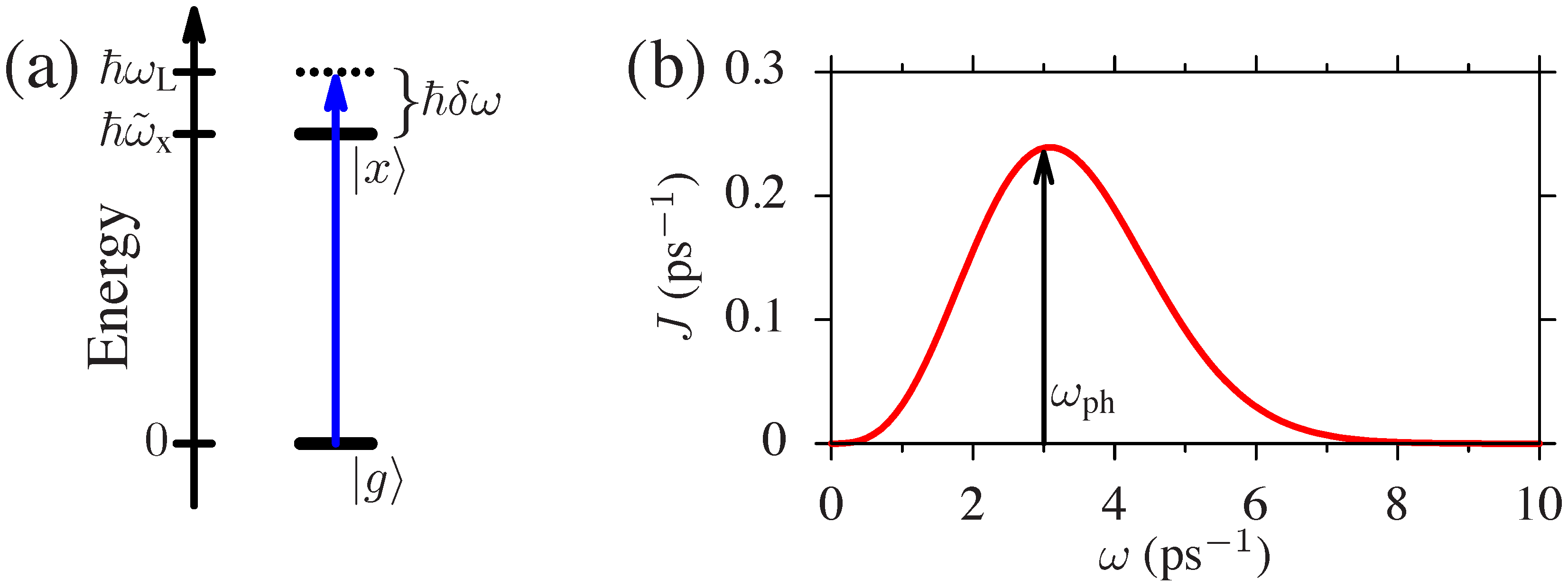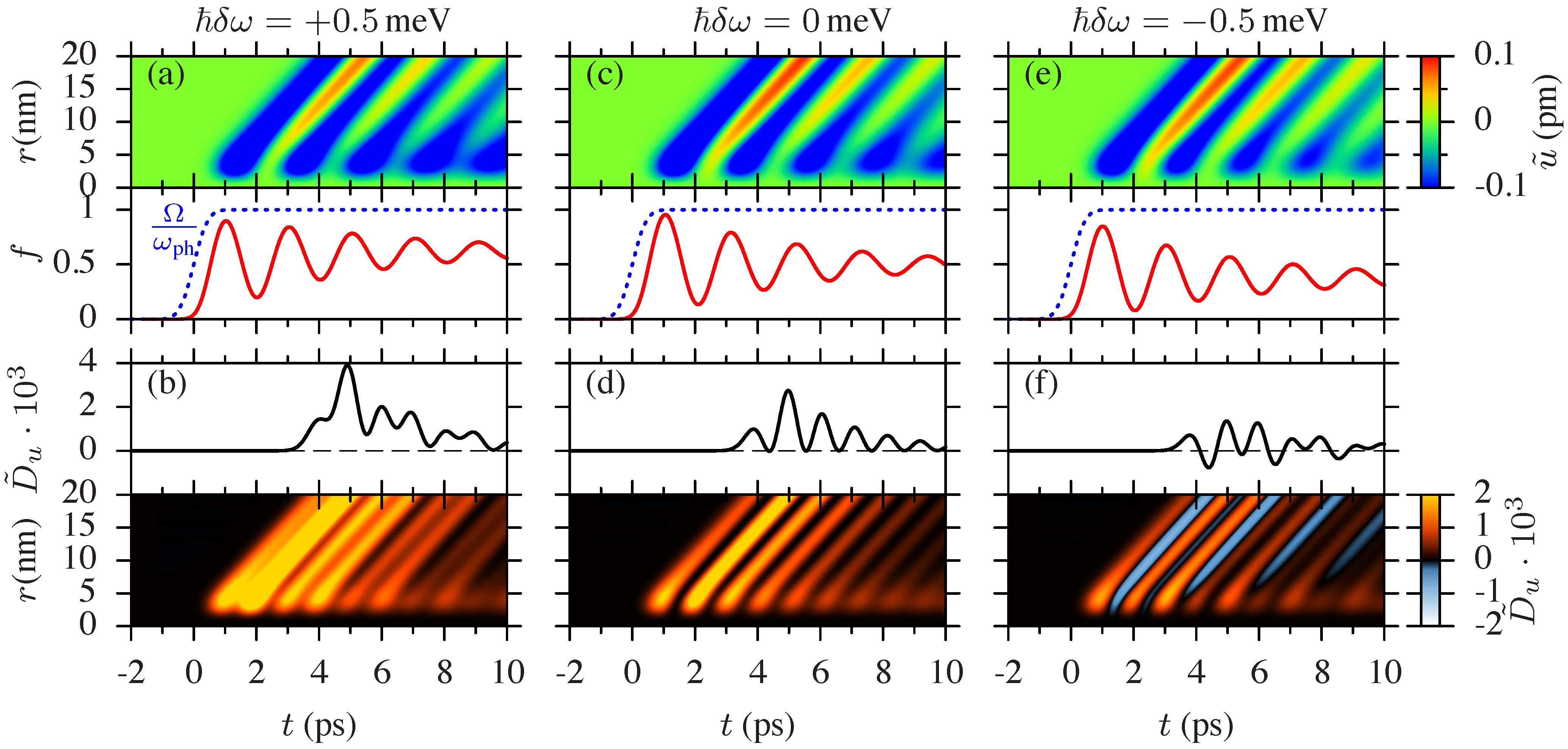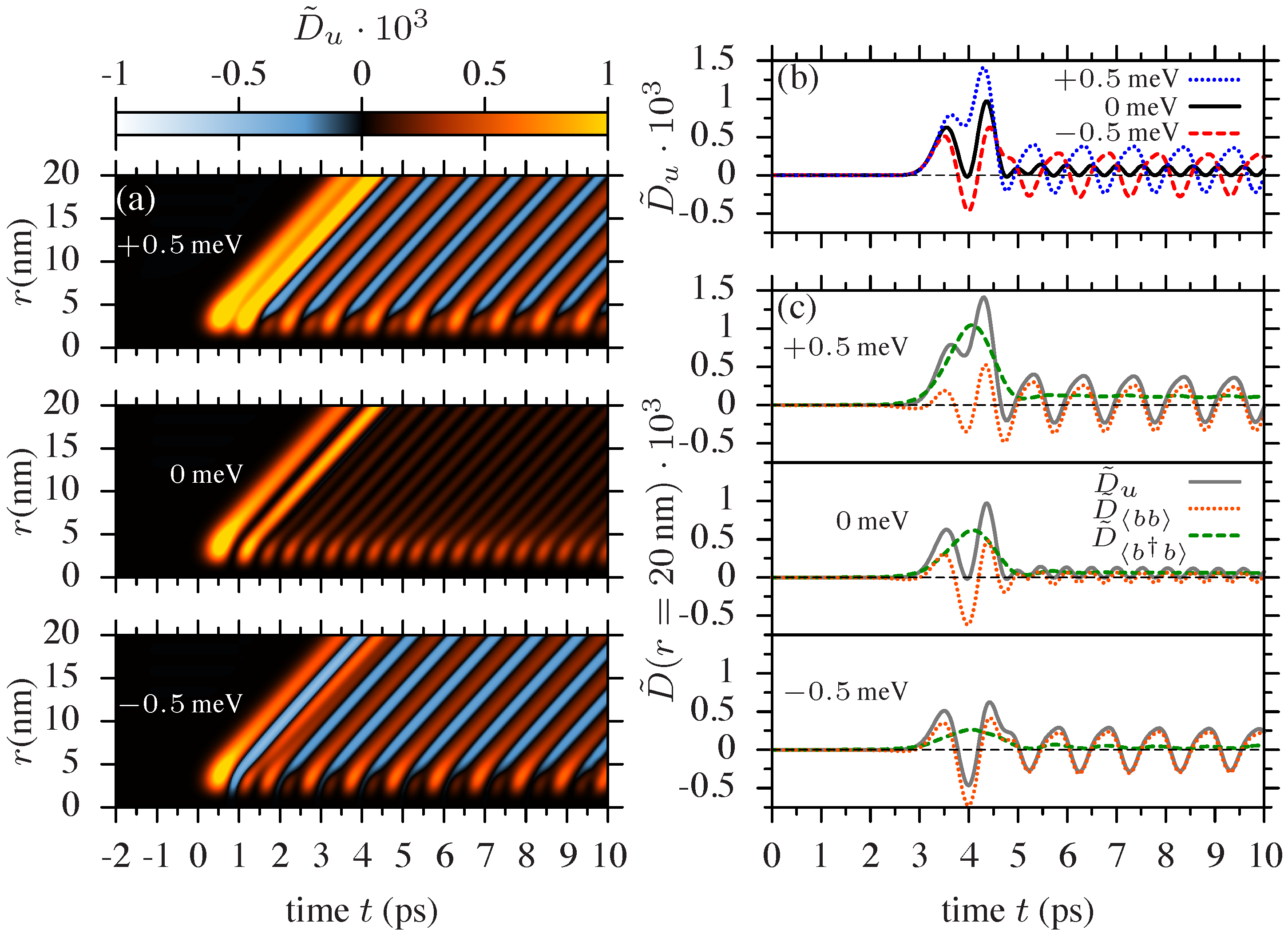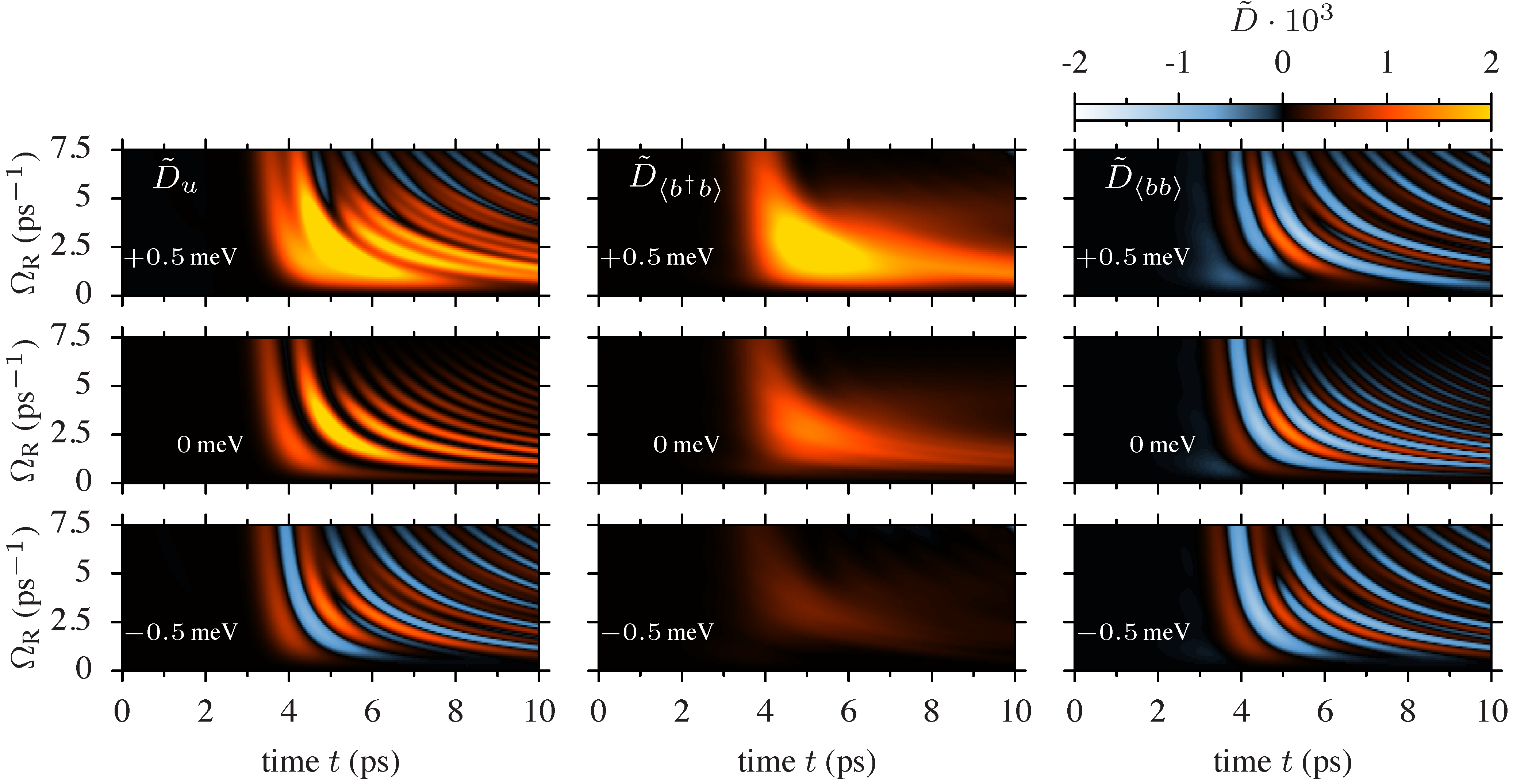We will first study the fluctuation properties for two different excitation strengths. One is chosen such that the Rabi frequency is in resonance with the phonon coupling, while the other is much stronger and far above the resonance condition. After that, we will give an overview of the occurrence of squeezing for various coupling strengths. To focus on the excitation-induced properties of the phonons, we restrict ourselves to the temperature , such that before switching on the light field . Initially, both the exciton and the phonon system are taken to be in their respective ground state. The exciton is driven by an optical CW field that is switched on according to Equation (9) with .
3.1. Rabi Frequency Resonant with Phonon Coupling
We start our discussion with a Rabi frequency
, which is in resonance with the phonon coupling.
Figure 2 shows the results for this excitation; it is structured as follows: The three different detunings
and
are shown from left to right. In the upper row ((a), (c) and (e)), we show the exciton occupation
(solid red lines), as well as the Rabi frequency
(dashed blue lines) in the lower panels and the mean lattice displacement
in the top panels. In the lower row ((b), (d) and (f)), we show the fluctuations
in the lower panels and their temporal profiles at
in the upper panels.
Let us first briefly discuss the upper row of
Figure 2,
i.e., (a), (c) and (e). The case of resonant excitation with
has been extensively studied in [
28], and we refer to that paper for further details on the dynamics of the lattice displacement. The exciton occupation
f (shown in the lower panel) performs the well-known Rabi oscillations with the Rabi frequency
that are damped in time due to the coupling to the LA phonons [
30,
38]. The upper panel of
Figure 2c shows the lattice displacement
(note that the values are scaled according to Equation (12)) plotted against time and distance from the QD. Every excitation of the exciton leads to the emission of a wave packet with a negative amplitude. Accordingly, each destruction of the exciton creates a wave packet with positive displacement. As the amplitude of the Rabi oscillation decays quite fast, also the amplitudes of the emitted phonons get smaller from one wave packet to the next one. Note that the oscillation period of the phonon wave packets is determined by the Rabi frequency
. Moving to detuned excitations in
Figure 2a,e, the overall behavior is rather similar. The oscillations now occur with the effective Rabi frequency
, which is, however, only slightly different from
. For positive detuning, the exciton occupation relaxes towards a slightly higher value, and for negative detuning, a slightly lower value compared to the resonant excitation is reached. These different long-time values can be best understood in the dressed state picture. At low temperatures, when no phonon absorption processes are possible, only transitions from the upper to the lower dressed state by phonon emission occur, such that, finally, only the lower dressed state is populated [
37]. Thus, the final exciton populations seen in
Figure 2 reflect the different contributions of the exciton state to the lower dressed state: at resonance, this state is an equal superposition of the ground and exciton state; for positive detuning, it is more exciton-like; and for negative detuning, it is more ground state-like. Since the initial state before switching on the light field is the ground state, phonon emission is more pronounced for positive detuning than for negative detuning.
Figure 2.
(a,c,e) Mean lattice displacement (upper panel); Rabi frequency Ω (dashed blue) and occupation f of the exciton state (solid red) (lower panel); (b,d,f) fluctuations of the lattice displacement (lower panel), as well as their temporal profiles at (upper panel): (a,b) positive detuning ; (c,d) resonant excitation ; (e,f) negative detuning .
Figure 2.
(a,c,e) Mean lattice displacement (upper panel); Rabi frequency Ω (dashed blue) and occupation f of the exciton state (solid red) (lower panel); (b,d,f) fluctuations of the lattice displacement (lower panel), as well as their temporal profiles at (upper panel): (a,b) positive detuning ; (c,d) resonant excitation ; (e,f) negative detuning .
The focus of this paper is the fluctuations of the lattice displacement
, which are plotted in the bottom row of
Figure 2,
i.e., (b), (d) and (f). The overall spatio-temporal structure (shown in the lower panels) follows the behavior of the displacement. The top panels show a temporal profile of the fluctuations at
. For the resonant excitation (
Figure 2d), in addition to the emission of coherent phonon wave packets, also an increase of the fluctuations above the vacuum level is found. It can be clearly seen that the fluctuations never go below zero, thus, the state is never squeezed. Having a more detailed look, we see that the maxima of the fluctuations appear exactly between the wave packets in the lattice displacement, where the slope of
is the largest, and that the fluctuations become minimal when there is a maximum or minimum in the displacement. This shows that the fluctuations oscillate with twice the Rabi frequency,
i.e.,
. Typically, an oscillation with twice the characteristic frequency of the phonon system is an indicator of squeezing, in particular in single mode systems. However, it has been found in other systems, as well, that oscillations with the double frequency may also appear without squeezing [
19].
For a positive detuning of
in
Figure 2b, we again see an oscillatory behavior of the fluctuations. Also in this case, the fluctuations are strictly positive; thus, no squeezing occurs. Furthermore, we see in the profile that the oscillation contains more than just twice the effective Rabi frequency, such that the oscillation looks rather irregular. In contrast, for the case of a negative detuning of
, the fluctuations clearly fall below zero on the slope of each wave packet. This means that the emitted wave packets are squeezed, and even a sequence of squeezed wave packets is generated by excitation with a CW light field. These findings are in line with other studies, where squeezed phonons arising from negatively detuned excitation of an electronic system were found [
12,
24]. In those studies, phonons with a fixed frequency, like optical phonons or phonons at van Hove singularities, were investigated. This means that the phonons have a vanishing group velocity, such that they do not move in space. The new feature in our system studied here is that the LA phonons form squeezed traveling wave packets that leave the QD.
Figure 3.
Fluctuations of the lattice displacement (solid grey), the two-phonon coherence (dotted orange) and the phonon occupation (dashed green) for (center), (left) and (right). All curves are calculated for .
Figure 3.
Fluctuations of the lattice displacement (solid grey), the two-phonon coherence (dotted orange) and the phonon occupation (dashed green) for (center), (left) and (right). All curves are calculated for .
To analyze the fluctuations
in more detail, we show the temporal profile at
again in
Figure 3 (solid grey line), where we now distinguish between the two contributions
(dashed green line) and
(dotted orange line) defined in
Section 2. We remind that
describes the fluctuations of the phonon occupations, and in this way, it includes the heating processes of the phonon system, while
refers to the fluctuations of the two-phonon coherence. Let us first concentrate on
. The behavior of these fluctuations is smooth and does not show any oscillatory behavior for any detuning, but they form roughly the mean value of the oscillatory full fluctuations
. In contrast, for
, an oscillatory behavior is seen. For resonant excitation, we see that it goes approximately with twice the Rabi frequency,
i.e.,
. For detuned excitation, a spectral analysis shows that the oscillation is composed of two frequencies, approximately
and
. It is interesting to note that an oscillation of the fluctuations with double and single phonon frequency was also found for squeezed longitudinal optical phonons after pulsed optical excitation [
19].
To understand whether squeezing occurs, we have to compare the strength of the two contributions and . For resonant excitation, the two parts have the same strength, such that they can compensate for each other. The minima in reach exactly zero, and no squeezing occurs. For positive detuning, as discussed above, the relaxation from the upper to the lower dressed state is associated with an increased phonon emission. When we think of to represent heating processes of the phonon bath, it is easy to understand that for a positive detuning, the fluctuations are larger than in the resonant case. It turns out that here, the heating processes always exceed the squeezing processes represented by . Therefore, the total fluctuations are always positive, and no squeezing occurs. For negative detuning, the lower dressed state has a larger ground state contribution, such that phonon emission processes are reduced compared to the resonant case, i.e., the heating is suppressed. Accordingly, is much smaller than , and the total fluctuations are dominated by the two-phonon coherence, thus leading to squeezing.
3.2. Rabi Frequency out of Resonance with Phonon Coupling
A drawback of the excitation with a Rabi frequency of
is the fact that the dephasing of the exciton is quite strong, such that the dynamics is limited to a short period of time. To avoid this pronounced damping in time, we now double the amplitude of the CW field to
. In [
28], we have shown that for Rabi frequencies in this region, a long sequence of wave packets can be emitted, because the exciton and the phonon system become increasingly decoupled and the dephasing mechanisms are suppressed. For a discussion of the mean lattice displacement
we again refer to [
28].
Figure 4a shows the fluctuations of the lattice displacement as a function of time and distance from the QD for the three detunings
and
. For the resonant excitation (central panel), only positive fluctuations are visible. After two large wave packets at the beginning that result from the switch-on process, all remaining amplitudes are almost of the same size. This reflects the very inefficient dephasing of the exciton state. Turning to detuned excitations, a surprising result is found for the fluctuations: not only for a negative detuning (
Figure 4a bottom), but also for a positive detuning (
Figure 4a top), pronounced negative fluctuations appear. We want to point out that in
Section 3.1 and in previous studies on similar systems, squeezed phonon states were only found for optical excitation energies smaller than the exciton transition [
6,
24]. For positive detunings, only enhanced fluctuations were observed [
6,
24].
Figure 4.
(
a) Fluctuations of the lattice displacement
as a function of
t and
r for a Rabi frequency
; (
b) temporal shape of the fluctuations of the lattice displacement
from (a) at
; (
c) same as
Figure 3 but for
.
Figure 4.
(
a) Fluctuations of the lattice displacement
as a function of
t and
r for a Rabi frequency
; (
b) temporal shape of the fluctuations of the lattice displacement
from (a) at
; (
c) same as
Figure 3 but for
.
To take a closer look at the temporal structure of the fluctuations, in
Figure 4b, we have plotted the profile of
for
for the three cases of the detuning
(dotted blue line), 0 (solid black line) and
(dashed red line). In the case of a resonant excitation (solid black), the minima of the fluctuations again reach zero, but never become negative. The frequency of this oscillation is approximately twice the Rabi frequency of the system,
i.e.,
. Note that, here,
, which essentially agrees with
. For the detuned cases (dashed red and dotted blue lines), the overall amplitude of the oscillation is enlarged, such that both reach negative values. Both curves look quite similar, but have a phase shift of
π. It is also clearly visible that the dominant frequency of the oscillation for the detuned cases is approximately the single Rabi frequency
, while the fast component with about
is weaker.
We again want to analyze the separate contributions to the fluctuations
. The results are shown in
Figure 4c in the same way as in
Figure 3. We recover some features from the previous case of strong phonon coupling at
. The fluctuations of the phonon occupation
(dashed green lines) again get larger for positive detuning and smaller for negative detuning; however, they are much smaller than in the case of strong phonon coupling. This is due to the fact that the phonon spectral density at
is much smaller now. The curves still do not exhibit a distinct oscillating structure, but are more or less constant after the strong wave packet from the switch-on process of the optical field that appears around
. It also still holds that the contributions
form the mean value for the full fluctuations
(solid grey lines). However, the important difference from
Figure 2 is the fact that the fluctuations of the two-phonon coherence
(dotted orange lines) clearly get larger than
for detuned excitations nearly independent of the sign of the detuning, which is quite remarkable. Additionally, as the previous discussion still holds, the phonon wave packets are squeezed when the two-phonon contributions dominate.
3.3. Dependence on Rabi Frequency
Let us now draw a complete picture and study the fluctuations as a function of the Rabi frequency. In
Figure 5 (left panel), we plot the profiles of the fluctuations
at
in a contour plot as a function of time
t and Rabi frequency
for the three different detunings. As expected, for zero detuning, we do not see any squeezing. For negative detuning, we find that for almost all Rabi frequencies
, squeezing occurs. For positive detuning, the situation turns out to be more complicated. While for small Rabi frequencies up to about
, no squeezing occurs, for higher Rabi frequencies around
, the fluctuations exhibit clear squeezing. We mention that also the lattice momentum exhibits no squeezing for resonant excitation and may exhibit squeezing for detuned excitations. We additionally plot the fluctuations of the phonon occupations
(middle panel) and the fluctuations of the two-phonon coherence
(right panel). Here, we can clearly see the difference between the three detunings. While for negative detuning, the fluctuations of the phonon occupations
are very small, for positive detuning, they become very strong. However, the important feature is that the main contributions of
are restricted to frequencies around
. This reflects the fact that only in this range of Rabi frequencies does pronounced phonon emission from the upper to the lower dressed state occur. The shape of this area in the plot does not change, but the detuning only contributes to a scaling of it, which can be understood from the fact that with increasing detuning, the contribution of the exciton state to the lower dressed state increases, and thus, more phonons are generated in the relaxation process. On the other hand, the strength of the fluctuations of the two-phonon coherence
are very similar for all three detunings. The main difference is that for zero detuning, they are strongest around
and become small for
, while in the detuned cases, also significant contributions arise from larger Rabi frequencies.
Figure 5.
Fluctuations of the lattice displacement (left), (center) and (right) at plotted against time t and Rabi frequency for the detunings (top); (middle) and (bottom).
Figure 5.
Fluctuations of the lattice displacement (left), (center) and (right) at plotted against time t and Rabi frequency for the detunings (top); (middle) and (bottom).








